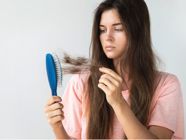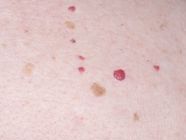Seborrheic dermatitis or seborrheic eczema is a common skin condition that causes dandruff and itching on the scalp.
In infants it is called "cradle cap", where the scalp appears greasy and flaky, but without itching. The information in this article is intended for older children and adults with seborrheic dermatitis. (1)
What is seborrheic dermatitis?
Seborrheic dermatitis is a type of skin inflammation that affects areas with many sebaceous glands, including the upper back, eyebrows, nose, beard — and the scalp as well, causing symptoms ranging from simple dandruff to itching. And a rash on the scalp.
In many cases, seborrheic dermatitis inflammation disappears without treatment or using a suitable shampoo, and in some cases it may require other treatments. (2)
Seborrheic dermatitis affects about 4% of adults, and is more common in men than in women. It usually appears after puberty, and the incidence increases significantly after the age of 20, reaching a peak at the age of 30 for men and 40 for women. (1)
What are the symptoms of seborrheic dermatitis? What does it look like?
- A skin rash appears on the scalp (either dry, oily, or a combination of both), with dandruff, and a burning sensation sometimes. It may also be accompanied by itching, ranging from mild to very severe, the intensity of which may vary from day to day. (3)
- Some people have the rash without any other symptoms. For people with dark skin, the rash often appears pink, purple, or lighter than the surrounding skin color. As for people with fair skin, they often have a red and prominent rash. (3)
- Symptoms can also appear on other areas of the body, such as the forehead, eyebrows, eyelids, behind or inside the ear, sides of the nose, beard, neck, back, or chest as well. (3)
If you think you may be suffering from seborrheic dermatitis, it is important to consult a specialist dermatologist to accurately diagnose your condition, especially since it may resemble other skin conditions, such as rosacea or psoriasis. Dermatology Department in Al-Ahli Hospital includes a team of experienced dermatologists who can provide optimal care for your condition.
What are the causes of seborrheic dermatitis inflammation? What makes it worse?
- Causes:
Doctors do not know the exact cause of seborrheic dermatitis infection, but they believe that it occurs as an inflammatory reaction linked to the overgrowth of the Malassezia fungus, which is a fungus found on everyone’s skin, but which reproduces excessively in some. The cause may also be hormonal changes, increased skin fat, or a problem with the immune system, and genetics may also play a role. (1) (4)
- Factors that make symptoms worse:
Some factors can trigger the symptoms of seborrheic dermatitis, or make them worse, but they are not the cause of the disease, such as: (4)
- Stress.
- Cold and dry weather.
- Infection or disease.
- Not contagious:
Seborrheic dermatitis inflammation is not contagious and it cannot be transmitted to others, whether by touch or other means.
How is seborrheic dermatitis inflammation treated?
Seborrheic dermatitis inflammation cannot be completely eliminated, as it is often a chronic condition that comes and goes, but some treatments can control it and reduce the chance of the inflammation recurring. (5) (6)
Treatment is usually with a medicated anti-dandruff shampoo that contains one of the following ingredients:
- Nizoral shampoo (contains antifungal / ketoconazole).
- Selenium.
- Zinc pyrithione.
- Coal tar.
To get the best benefit from your anti-dandruff or anti-fungal shampoo, follow the instructions carefully:
- Wet your hair with water.
- Put an amount of shampoo on your hand.
- Use your fingertips to distribute the shampoo onto the scalp (focus on the scalp, not the hair itself).
- Massage the shampoo into the scalp well.
- Wait 5-10 minutes then rinse well.
- Frequency of use; Use shampoo as directed by your doctor or pharmacist or according to the instructions on the package. You may need to use it a few times a week at first, then gradually reduce use after your symptoms improve.
Other treatments:
- Scalp scrub:
It helps remove thick flakes on the scalp, and it is preferable to use it before other treatments to help it penetrate deeper into the scalp better. Examples include scrubs that contain coconut oil and salicylic acid.
- Cortisone (severe inflammation):
If the scalp is inflamed, the doctor may prescribe a topical shampoo or cream containing a mild cortisone that is used for a short time.
References
- National Eczema Society - Seborrhoeic dermatitis in adults
- National Eczema Association - Seborrheic Dermatitis
- American Academy of Dermatology Association - SEBORRHEIC DERMATITIS: SIGNS AND SYMPTOMS
- The Society for Pediatric Dermatology - What is seborrheic dermatitis?
- British Association of Dermatologists - Seborrhoeic dermatitis
- Cleveland Clinic - Seborrheic Dermatitis






